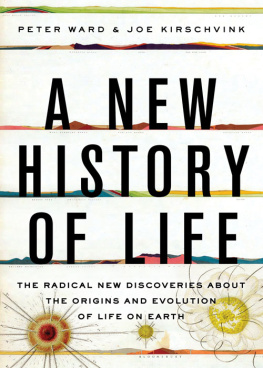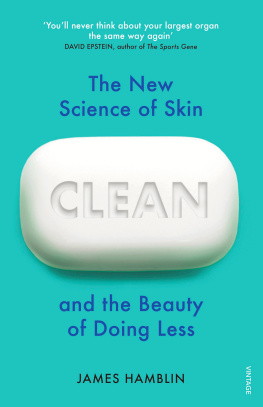
THE CLEAN BODY
THE CLEAN BODY
A MODERN HISTORY

PETER WARD
McGill-Queens University Press
Montreal & Kingston London Chicago
McGill-Queens University Press 2019
ISBN 978-0-7735-5938-7 (cloth)
ISBN 978-0-2280-0062-4 (ePDF)
ISBN 978-0-2280-0063-1 (ePUB)
Legal deposit third quarter 2019
Bibliothque nationale du Qubec
Printed in Canada on acid-free paper that is 100% ancient forest free
(100% post-consumer recycled), processed chlorine free
This book has been published with the help of a grant from the Canadian Federation for the Humanities and Social Sciences, through the Awards to Scholarly Publications Program, using funds provided by the Social Sciences and Humanities Research Council of Canada.

We acknowledge the support of the Canada Council for the Arts.
Nous remercions le Conseil des arts du Canada de son soutien.
Library and Archives Canada Cataloguing in Publication
Title: The clean body : a modern history / Peter Ward.
Names: Ward, W. Peter, author.
Description: Includes bibliographical references and index.
Identifiers: Canadiana (print) 20190132876 | Canadiana (ebook) 20190132884 | ISBN 9780773559387 (cloth) | ISBN 9780228000624 (ePDF) | ISBN 9780228000631 (ePUB)
Subjects: LCSH: HygieneWestern countriesHistory. | LCSH: LaundryWestern countriesHistory. | LCSH: Bathing customsWestern countriesHistory.
Classification: LCC RA780 .W37 2019 | DDC 613/.4dc23
This book was typeset in 10.5/13 Sabon.
For PCW
once more and forever
A MARCORD
Al so, al so, al so,
Che un om a zinquentann
Lha sempra al mni puloidi
E me a li lv do, tre volti e d,
Ma l sultnt sa m vaid al mni sporchi
Che me a marcord
Ad quand cha sera burdll.
Federico Fellini
CONTENTS
PREFACE
BEGINNINGS
This book takes its origins from two small incidents in my own life, one at either end of my professional career. The first was a casual remark by my grandfather. When a student in the early 1970s, I taped an interview with him for an oral history project run by an archive in the western Canadian province where he lived. They were documenting the communitys past through interviews with older residents and, having lived there for most of his adult life, he certainly qualified. A successful small businessman and community leader, he was typical of many who came west from central Canada during the early years of the century. The interview must have been an important occasion for him because he dressed for it in his Sunday best, even though we were meeting at home. The conversation itself was a pleasure as he journeyed back and forth across the broad plains of his memory, from his childhood in Montreals Griffintown through his farmboy adolescence on a back concession in eastern Ontario and his early years as a mine worker in the Rockies to his long odyssey as a hardware merchant and local notable in smalltown Alberta. No expert interviewer, I simply let him tell me his story, and he did.1 Today I remember little of what he said apart from an offhand remark about his youthful bathing habits. Facilities such as we know them today, he told me, were unknown at that time. You had a bath maybe once in six months. We must have smelled to high heaven although I never noticed it. Since then Ive often wished Id had the wit to pursue the subject with him but, still learning my craft and a neophyte with a tape recorder and microphone, I let the opportunity slip. Yet the comment itself lingered in the back of my mind, teasingly, for decades.
Some forty years later the tease had become a curiosity and Id begun to explore the long history of personal cleanliness. My wife Patricia and I had rented a quirky flat just a few steps from Londons verdant Hampstead Heath while I trolled through the British Library. The daily commute to Euston Road was relatively short and I had the choice between the bus and the Underground to vary the routine. While the tube station was a bit farther from our apartment and the journey just a rattling rush through a long dark tunnel, usually it was the better choice during the heavy morning traffic, though you never really could be sure. Large creaking elevators connected the Hampstead station with the platforms below, and at peak hours, commuters crammed themselves in, sharing a closeness with strangers theyd never accept otherwise. One morning I missed my timing and arrived at the station just at the height of the rush. I wedged myself into the next elevator, heard the door slam shut, and felt the usual lurch as it began its descent. Pressed tightly against my nearest neighbours, I caught a whiff of the English middle class setting off for a day at the office. I sniffed gently, then breathed deeply, and what did I smell? Coffee. Someone with a more tutored nose than mine might have parsed the bouquet de Hampstead Village more subtly, sensing perfumes and soaps, lotions and hair preparations of delicacy and refinement. But for me the overwhelming aroma of the moment was coffee, certainly not any of the bodys natural odours. On that short journey from Hampstead station down to the platform below I learned a lesson that only experience could have taught: the modern Western body has lost its own aromas and is now overwhelmed by the scents offered by the age of mass consumption.
For me these two short encounters raise the main question of this book: how have we come to be so clean? My grandfather must have had a pong as a boy, but by the time I knew him his personal habits were well above reproach. He bathed often and changed his clothes regularly just like everyone else I knew. At some point in his young life he must have learned new habits. Presumably the change was part of growing up: like Fellini, he adopted adult ways of being. No doubt he shared the common experience of children and youths in his own time, learning the lessons of cleanliness current in late Victorian Canada. But his personal growth merely begs larger questions. After all, standards of personal hygiene were in flux across the Western world in his time. By then theyd been in evolution for generations, as theyd remain for most of the next century. How was the body cared for before the great hygienic transformation? What broader influences underlay the changes that then occurred? When and where and how and why did traditional notions of bodily care become todays grooming practices? What material conditions underlay these processes? What ideas shaped beliefs about the clean body, who circulated them, and why did they do so? How was the cleanliness revolution connected to the coming of the modern age? In short, what was the larger historical meaning of my brief elevator ride at the Hampstead tube station on that sunny October morning in the early twenty-first century?

Plate 1 | Bartolomeo Pinelli, La famiglia dei pedochiosi [The family with lice], late eighteenth/early nineteenth century. Wellcome Collection, CC BY.
Next page


















